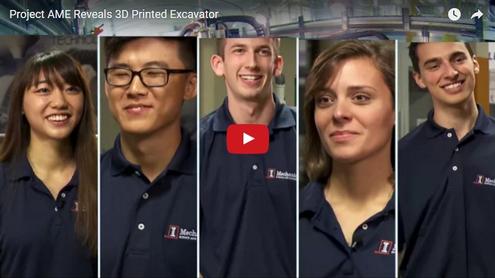World’s First 3D Printed Excavator Just Got One Step Closer to Reality

For the past two years a conglomerate of trade associations, industry, government and academia have been collaborating on the world’s first operational 3D printed excavator. That project made a giant leap forward with the recent printing of a prototype that leveraged large-scale additive manufacturing technologies and further explores the feasibility of printing with metal alloys.
Known affectionately as Project AME (Additive Manufactured Excavator), the excavator is being 3D printed using various machines at the Oak Ridge National Laboratory’s Manufacturing Demonstration Facility (MDF) to create and assemble three components: the cab, the boom, and a heat exchanger. The excavator’s boom will be fabricated using a newly developed free-form additive manufacturing technique to print large-scale metal components. 3D printing an excavator for the first time has been a learning experience for both seasoned researchers and the next generation of engineers.
A student engineering team from the University of Illinois at Urbana-Champaign won a design competition and was on-hand at the MDF to watch their cab design take shape on the big area additive manufacturing machine – using carbon fiber-reinforced acrylonitrile butadiene styrene, or ABS, plastic. Their reaction could only be described as pure joy.
“The reaction of the UIUC team was like watching kids on Christmas morning,” said John Rozum, show director for IFPE 2017. “They worked hundreds of hours on this project and it was incredible to see them finally get to watch the printing process and see their design in full size.”
The excavator is a collaboration between the Association of Equipment Manufacturers (AEM), National Fluid Power Association (NFPA), Center for Compact and Efficient Fluid Power (CCEFP), Oak Ridge National Laboratory (ORNL) and the National Science Foundation (NSF). This project was supported by DOE’s Office of Energy Efficiency and Renewable Energy – Advanced Manufacturing Office.
CCEFP academic partners – Georgia Tech (GT), University of Illinois, Urbana-Champaign (UIUC), and University of Minnesota (UMN) – are leading the research activities for Project AME. A GT research team is designing the additively-manufactured steel boom, stick and bucket. A UMN research team is responsible for the aluminum-powder bed 3D-printed oil cooler design. The Oak Ridge National Laboratory (ORNL) is developing all processes required to 3D-print these excavator components.
“The project idea came about during a tour of ORNL in 2014, when members of the CCEFP saw the 3D-printed car,” said Eric Lanke, chief executive officer of NFPA. “Discussions ensued about what could make a similar splash for the fluid power and mobile equipment industry. Like many brainstorming sessions, one thing led to another and it was decided that a working excavator was a natural fit.”
Project AME will be on display at IFPE and CONEXPO-CON/AGG 2017 as part of the new Tech Experience. Visitors to the show will be able to Imagine What’s Next in our industry with the new Tech Experience – a 75,000+ square foot immersive, future-forward showcase of the evolution in materials, machines, systems and software that will spark a revolution in how we build, where we work, and the jobs for years to come. The joint trade shows take place March 7-11, 2017 in Las Vegas, Nevada.
Originally published by IFPE on September 28, 2016.